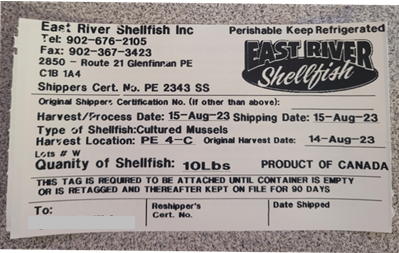The FDA is advising consumers not to eat, and restaurants and food retailers not to sell, and to dispose of cultured mussels from East River Shellfish Inc. from harvest location PE 4-C that were harvested on Aug. 14 and shipped on Aug. 15. to retailers in Ill., Mass. and N.Y. due to the possible presence of Salmonella and E. coli. East River Shellfish Inc. is based in Glenfinnan, Prince Edward Island, Canada.
The following photo contains a product tag that would be attached to original containers of the affected mussels:
 Source: FDA
Source: FDAContaminated mussels can cause illness if eaten raw, particularly in people with compromised immune systems. Food contaminated with Salmonella and E. coli may look, smell and taste normal. Consumers of these products who are experiencing symptoms of salmonellosis or E. coli should contact their health care provider, who should report their symptoms to their local health department.
Symptoms of Salmonella infection
Most people infected with Salmonella will begin to develop symptoms 12 to 72 hours after infection. The illness, salmonellosis, usually lasts four to seven days, and most people recover without treatment.
Most people with salmonellosis develop diarrhea, fever, and abdominal cramps. More severe cases of salmonellosis may include a high fever, aches, headaches, lethargy, a rash, blood in the urine or stool, and in some cases may become fatal.
Due to the range in severity of illness, people should consult their health care provider if they suspect that they have developed symptoms that resemble a Salmonella infection.
Symptoms of E. coli infection
E. coli are mostly harmless bacteria that live in the intestines of people and animals and contribute to intestinal health. However, eating or drinking food or water contaminated with certain types of E. coli can cause mild to severe gastrointestinal illness. Some types of pathogenic, or illness-causing, E. coli, such as Shiga toxin-producing E. coli (STEC), can be life-threatening.
People infected with pathogenic E. coli can start to notice symptoms anywhere from a few days after consuming contaminated food or as much as nine days later. Generally, the symptoms include severe stomach cramps, diarrhea, fever, nausea and/or vomiting.
The severity or presence of certain symptoms may depend on the type of pathogenic E. coli causing the infection. Some infections can cause severe bloody diarrhea and lead to life-threatening conditions, such as a type of kidney failure called hemolytic uremic syndrome (HUS), or the development of high blood pressure, chronic kidney disease, and neurologic problems. Other infections may have no symptoms or may resolve without medical treatment within five to seven days.
Due to the range in severity of illness, people should consult their health care provider if they suspect that they have developed symptoms that resemble an E. coli infection., including HUS.
People of any age can become infected with pathogenic E. coli. Children under the age of 5 years, adults older than 65 and people with weakened immune systems are more likely to develop severe illness as a result of a pathogenic E. coli infection. However, even healthy older children and young adults can become seriously ill.
Summary of problem and scope
On 8/21/2023, the Canadian Food Inspection Agency tested mussel meats and discovered the presence of Salmonella and high levels of generic E. coli. On 8/23/2023, the CFIA informed the FDA of the testing results from the contaminated product. The CFIA food safety investigation into the cause of the problem is ongoing.
The FDA is awaiting further information on distribution of the mussels and will continue to monitor the investigation and provide assistance to state authorities as needed.
Recommendations for consumers
Consumers who have symptoms should contact their health care provider to report their symptoms and receive care.
To report a complaint or adverse event — illness or serious allergic reaction — consumers can:
- Call an FDA Consumer Complaint Coordinator if they wish to speak directly to a person about their problem.
- Complete an electronic Voluntary MedWatch form online.
- Complete a paper Voluntary MedWatch form that can be mailed to FDA.
Visit www.fda.gov/fcic for additional consumer and industry assistance.
Additional information
.jpg?1700234864)
.jpg?height=200&t=1700234864&width=200)

Report Abusive Comment